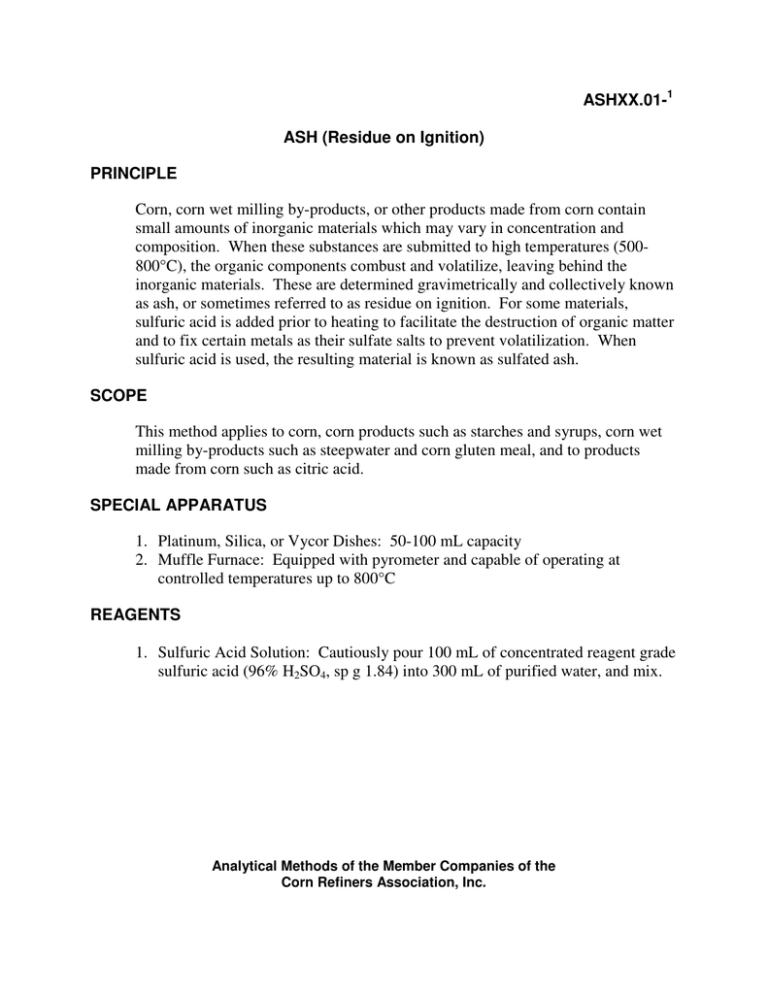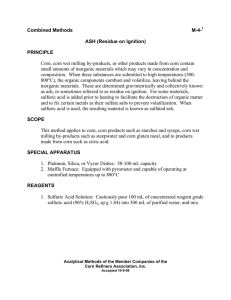ASHXX.01- ASH (Residue on Ignition) PRINCIPLE
advertisement

ASHXX.01-1 ASH (Residue on Ignition) PRINCIPLE Corn, corn wet milling by-products, or other products made from corn contain small amounts of inorganic materials which may vary in concentration and composition. When these substances are submitted to high temperatures (500800°C), the organic components combust and volatilize, leaving behind the inorganic materials. These are determined gravimetrically and collectively known as ash, or sometimes referred to as residue on ignition. For some materials, sulfuric acid is added prior to heating to facilitate the destruction of organic matter and to fix certain metals as their sulfate salts to prevent volatilization. When sulfuric acid is used, the resulting material is known as sulfated ash. SCOPE This method applies to corn, corn products such as starches and syrups, corn wet milling by-products such as steepwater and corn gluten meal, and to products made from corn such as citric acid. SPECIAL APPARATUS 1. Platinum, Silica, or Vycor Dishes: 50-100 mL capacity 2. Muffle Furnace: Equipped with pyrometer and capable of operating at controlled temperatures up to 800°C REAGENTS 1. Sulfuric Acid Solution: Cautiously pour 100 mL of concentrated reagent grade sulfuric acid (96% H2SO4, sp g 1.84) into 300 mL of purified water, and mix. Analytical Methods of the Member Companies of the Corn Refiners Association, Inc. ASHXX.01-2 ASH (Residue on Ignition) — continued METHOD PARAMETERS TABLE Sample Type Sample Weight (g) Corn Corn Starch Corn Syrup Corn Sugar Feedstuffs Steepwater Citric Acid 5 5 20 – 40 5 – 10 5 2 2 – 20 Method: Non-sulfated or sulfated Non-sulfated Non-sulfated Sulfated Sulfated Non-sulfated Non-sulfated Sulfated Muffle Furnace Temperature 525 – 600°C 525 – 600°C 525 – 600°C 525 – 600°C 525 – 600°C 525 – 600°C 800°C Time in Muffle Furnace 4 hours 4 hours 4 hours 4 hours 4 hours 2 hours 15 minutes Notes 1-4 2-5 2, 3, 6-9 2, 3, 7-9 2-4, 10 2-4, 11 2-4, 12 PROCEDURE Non-Sulfated Method: 1. If necessary, grind the sample. 2. If necessary, dry the sample, noting the moisture content. 3. Weigh accurately, to the nearest 0.0001 g, the specified amount of sample into a pre-heated, cooled, and accurately tared platinum or silica dish. 4. Heat over an open flame, under an infrared heat lamp, or on a hot plate until sample is thoroughly carbonized. Ignite the sample during this charring process. 5. Place in a muffle furnace at specified temperature for specified time or until ash is free from carbon. 6. Cool in a desiccator and weigh. Sulfated Method: 1. Weigh accurately, to the nearest 0.0001 g, the specified amount of sample into a pre-heated, cooled, and accurately tared platinum or silica dish. 2. Add 5 mL of sulfuric acid solution, and mix by swirling or stirring with a glass rod. 3. Place dish in a forced air oven at 105°C overnight (16 hours or longer) or on steam bath. 4. Remove dish with sample from oven or steam bath and heat gently over an open flame, under an infrared heat lamp, or on a hot plate until sample is thoroughly carbonized. Ignite the sample during this charring process. ASHXX.01-3 ASH (Residue on Ignition) — continued 5. Place in a muffle furnace at specified temperature for specified time or until ash is free from carbon. 6. Cool in a desiccator and weigh. CALCULATION % Ash (as is) = % Ash (dsb) = Ash Wt. (g) x 100 Sample Wt. (g) Ash Wt. (g) x 100 x 100 Sample Wt. (g) x (Dry Substance Wt. (%)/100) NOTES 1. Typically for whole corn, the moisture content is measured by a double dry technique on approximately 50 g of sample. A portion of this dried, ground sample is used for ashing. 2. Covering the dish with a watch glass before transfer minimizes the risk of losing ash residue. 3. If sample is difficult to ash, the dish may be removed from the muffle, cooled, and the residue moistened with a few drops of purified water. Heating is then continued. 4. Special attention should be given during the preliminary carbonization step, since excessive foaming may cause loss of sample and ash. 5. In the case of starch containing added inorganic materials, use sufficient sample to provide from 50 to 200 mg of ash. 6. Larger samples are desirable when analyzing ion exchange refined corn syrups (e.g. high fructose corn syrup). Up to 40 g of syrup with 10 mL of sulfuric acid solution can be ashed successfully by careful preliminary heating and by extending the time in the furnace to guarantee a carbon-free residue. Alternative, two 20-g portions of syrup may be ashed successively in the same dish. 7. Platinum dishes are recommended when ash level is low, as is the case with ion exchanged syrups. Platinum dishes rarely lose weight during ignition, whereas silica and Vycor dishes are subject to weight losses. 8. Inadequate dehydration of syrup and sugar samples may result in a violent eruption during carbonization and consequent sample loss. ASHXX.01-4 ASH (Residue on Ignition) — continued 9. In samples containing sodium chloride as the principal inorganic salt, the chloride ash may be calculated by multiplying the sulfated ash value by a factor of 0.85. 10. Sweetened feedstuffs should be run by the sulfated ash method if the sugar content is more than 20%. 11. The liquid must be evaporated gently to dryness to avoid sample loss by bumping or excessive foaming. Steepwater is rich in minerals that can be lost during excessive heating in the muffle furnace. 12. About 2-5 g of solid citric acid are needed, while liquid citric acid solutions may require 10-20 g depending on the dry solids content. Liquids should be evaporated gently to dryness prior to addition of the sulfuric acid. REFERENCE Adapted from Food Chemicals Codex, Current Edition, United States Pharmacopeia (USP), Rockville, MD. METHOD HISTORY Combined the Ash methods for Corn(A-4), Corn Starch (Unmodified) (B-8), Corn Syrup (E-6), Corn Sugar (F-6), Feedstuffs (G-4), and Steepwater (J-14) on 10-9-2009. Corn, Ash (A-4), Date of Acceptance 6-3-1957, Revised 4-18-1989. Corn Starch (Unmodified), Ash (B-8), Date of Acceptance 5-23-1955, Revised 310-1997. Corn Syrup, Ash (E-6), Date of Acceptance 8-25-1952, Revised 6-13-1985. Corn Sugar, Ash (F-6), Date of Acceptance 11-18-1958, Revised 4-14-1978. Feedstuffs, Ash (G-4), Date of Acceptance 11-15-1955, Revised 4-18-1989. Steepwater, Ash (J-14), Date of Acceptance 11-16-1964, Revised 10-20-1987. ASHXX.01-5 ASH (Residue on Ignition) — continued








